Korean food, while not as famous worldwide as neighbouring cuisines like Chinese, Japanese and Thai, is still an incredibly diverse and seriously tasty cuisine. During the three and a half years we spent living in Korea, we learned that food plays an important part in Korean traditions and some Korean dishes are even believed to have medicinal purposes; male stamina being one of these! And anyone who has ever met a Korean person will most likely have heard about the healing properties of kimchi!
Certain Korean dishes are prepared for holidays and traditional ceremonies such as the mass-consumption of songpyeon during Chuseok, the Korean Thanksgiving holiday. Other dishes are eaten at certain times, or even days, of the year; for example, on April 14th ] aka Black Day, singles gather together and eat jjajangmyeon or noodles with black bean sauce. This is kind of like an anti-Valentine’s Day where single people who didn’t get a gift on Valentine’s Day or White Day (March 14th – a totally made up east Asian holiday celebrated in Japan, Korea, China and Taiwan, where women get gifts, usually chocolates, as they are expected to give gifts to men on Valentine’s Day) gather together in the blackness of their depression of not getting chocolates or having a romantic partner the preceding months!
With all of these traditions and customs surrounding Korean food, it shouldn’t come as a surprise that Koreans are real foodies and often certain restaurants become famous for just one particular dish.
At first, some of the spicy fermented flavours can be very harsh on a Korean food virgin’s palate, ahem Kimchi ahem! But, once you get accustomed to the tastes and textures, you’ll be hooked! Korean cuisine is definitely quite meat-intensive but there are plenty of vegetarian Korean foods and vegetarian- friendly dishes to try. While most people know about Korean barbeque, which we ate more than our fair share of during our time living in Korea, we have since become pescatarians and wanted to highlight tastier, healthier, lesser-known and less meat-heavy dishes that can be found throughout the Korean peninsula.
Amazing Korean Dishes For Pescatarians
Here are some of the staples we loved during our time in Korea, some of which we’d choose over an Irish dinner any day!
Kongnamul-gukbap (콩나물국 밥) – Bean Sprout Soup With Rice
This soup is said to cure hangovers and we put that to the test on many a Sunday in Korea! Obviously, it can also be enjoyed when you’re in full health and it’s also really good in winter if you have a cold, or just are cold! It’s a bean sprout soup with rice, usually made from dried anchovy stock with garlic and green onion. It can be spicy with red pepper flakes or you can ask for it mild if spice is not your thing. If you do like it spicy you should say “mae-un”( 매운) when ordering as sometimes the red pepper flakes are left out for non-natives – there’s an assumption that us non-Koreans can’t handle the heat!
Usually, it’s served with a part cooked egg on the side and some ‘kim’ (김) or dried seaweed which you can use to make little rice-beansprout-egg wraps. It’s customary to spoon out some of the rice and broth in with the egg to make a kind of rice porridge. Often times Kongnamul-gukbap restaurants are 24 hour. We’ve also have seen a whole egg served alongside where you crack the egg into your soup and let it cook a little before stirring. Korean cuisine is all about DIY and if you’re unsure what to do, restaurant staff will always help you out! This is one of our all-time favourite Korean foods. And not just because it’s a great cure – it’s really tasty!
Kimchi-jjigae (김치 찌개) – Kimchi Stew
This is a stew (jjigae) made from anchovy broth and the famous Korean side dish kimchi (pickled fermented cabbage), seasoned with chilli paste( gochujang) or chilli powder (gochu garu). Common vegetables include spring onion, scallions and garlic. Sometimes there is pork inside but you can ask for this to be left out – just say “gogi baego” which means “without meat”. It comes in a traditional Korean dish called a dolsot (돌솥) and is still bubbling as you tuck in. It’s so good and the spice warms you up during Korean winters. As usual in Korea, rice and side dishes (banchan) usually kimchi and danmuji (pickled radish) accompany. Of course, what you need on the side of your kimchi stew is more kimchi!
Sundubu-jjigae (순두부 찌개) – Spicy Soft Tofu Stew
This is a variant of kimchi-jjigae with soft tofu (dubu) added. It contains the same basic ingredients; with tofu being the main feature and sometimes mushrooms. It can come with seafood, usually clams, or meat, usually pork. An egg is added right before serving so this dish has a double protein hit which makes it a great choice for a quick dinner after the gym. It’s also served in a dolsot.
Kimbap (김밥) – Korean Seaweed Roll
Kimbap, literally “seaweed rice”, is Korea’s version of futomaki sushi but where Japanese sushi has rice vinegar, gimbap has sesame oil making it that bit tastier. White rice is rolled in dried seaweed with vegetables, usually cucumbers, spinach, carrots and danmuji (pickled radish). Protein ingredients are usually fish, spam, processed crab meat, cooked egg and/or seasoned beef. Our favourite was tuna or chamchi Kimbap (참치김밥). It’s filled with tuna, marinated sesame leaf, and mayonnaise as well as vegetables. Usually, the spam or crab doesn’t feature in tuna kimbap but kimbap is usually made up at a deli-style counter so you can point at what you don’t want in your roll and say “ego baygo juseyo” (without this please).
Kimbap is a popular snack food or light lunch and is often the first choice to bring on hiking trips because it is so handily wrapped in tin foil when you get it to go. It’s kind of like our version of a sandwich or filled baguette. You’ll find 24-hour gimbap shops (Kimbap World ‘김밥 나라’ and Kimbap Heaven ‘김밥 천국’, the two most common chains) on almost every street corner in Korea which serve not only gimbap but a range of other dishes.
Triangle or ‘samgak’ (three-sided) Kimbap (삼각김밥) is a triangle-shaped gimbap sold in all convenience stores with a variety of fillings. Again, tuna mayo or spicy tuna were our favourites.
Bibimbap (비빔밥) – Rice Mixed With Vegetables
This is one of the most famous Korean dishes after barbeque; it’s a signature dish and there are plenty of restaurants that specialise in this humble meal. Basically, it’s Korean fish and chips – but a whole lot healthier. Bibimbap literally means “mixed rice” and it’s made up of warm white rice in a silver bowl covered with various vegetables; carrots, dried seaweed, cucumbers, sprouts, radish, kimchi and topped with gochujang (red chilli pepper paste). Sometimes sliced beef is added so be prepared with the phrase “gogi baego” if you don’t want meat inside. Bibimbap is topped with a sometimes raw but more commonly fried egg. Some places will give you the red chilli paste separately if you want to control the spice level of your meal. The ingredients should be stirred together thoroughly just before eating.
Dolsot bibimbap is essentially the same dish but served in a hot stone bowl, keeping it warm. Before the rice is put in, the bowl is coated with sesame oil which causes the rice to continue cooking and it goes all crunchy and stick to the sides of the dolsot dish – this is our bibimbap of choice, so much better than the original!
Janchi-guksu (잔치 국수) – Noodle soup with vegetables
Janchi-guksu is a delicious noodle soup dish made from wheat flour noodles in a light anchovy broth with dasima, or kombu, a kelp widely eaten in East Asia. This dish is served with a sauce made from sesame oil, soy sauce, and small amounts of chilli pepper powder and scallions. Thinly sliced fried egg, seaweed, and zucchini are added on top of the dish as garnishes. The name derives from the word janchi, literally “feast” or “banquet”. This dish is traditionally eaten to celebrate special occasions such as Korean weddings – which are quite a different experience to Irish weddings! The word guksu means “noodles” and noodles symbolise longevity – in both life and in marriage. Because these noodles are traditionally eaten at weddings, the expression “When are you going to treat us to us guksu?” is a way of asking “When are you getting married?”. In fact, this dish is such a prolific symbol of Korean weddings that wedding days are often described as “a day to eat guksu”.
Hoedeopbab (회덮밥) – Raw fish with rice and vegetables
Hoedeopbap is a variation of bibimbap and is made up of steamed rice mixed with sliced or cubed fresh ‘hoe’ (pronounced ‘hway’) or raw fish, similar to sashimi, various vegetables such as lettuce, cucumber and sesame leaves, sesame oil, and chogochujang (a sauce made from vinegar, gochujang, and sugar). The fish used for making hoedeopbap is generally either halibut, sea bass, rockfish, tuna, salmon, whitefish, or sometimes octopus and each bowl of rice can contain either one or multiple varieties of seafood. Just like bibimbap, it’s all mixed up together before eating and it’s really, really good!
Jangeo gui (장어구이) – Grilled Eel / Eel Barbeque
When we decided to come back to Korean for a month to housesit one of our biggest concerns was the smells of barbequed meat wafting out onto the streets and tempting us back to a fully carnivorous lifestyle! That, with all the fried chicken and beer places, make Korea a difficult country to be a vegetarian in but luckily for us, we still eat seafood! I remembered a trip with co-teachers from the last time we taught English in Korea where we had eel barbeque! Phew!
It’s the same deal as pork or beef barbeque, you usually need to order at least two portions of eel, it comes out raw and you cook it yourself at your table. The best places have actual coal barbeques set into barrels.
All the usual side dishes accompany; raw garlic, lettuce leaves, sesame leaves, kimchi, a soup, ssamjang (a spicy red pepper garlic sauce) and the eel barbeque includes raw ginger too because, well, it’s fish I suppose. You should cut up your eel into smaller bite-sized pieces, if it has not already been, while it’s cooking. When it’s cooked wrap each little piece of eel up in a lettuce leaf with whatever else you want, garlic, ginger and ssamjang is a great combination, and pop it into your mouth. Repeat until full or all the eel is gone. If you’re not full, order more! This dish is usually enjoyed with bokbunja, Korean black raspberry wine, as eel is one of the things that’s good for male stamina… maybe because it’s snake-shaped?
Isaac Toast (이삭 토스트) pronounced “ee-sag tos-eu-teu” – Cheese Toast Sandwich
Okay, while technically this is a Korean take on a basic sandwich there is something slightly addictive about it. I knew I had become a bit Korean-ised when one day back in Ireland I was a little hungover and craving an Isaac cheese toast instead of a typical breakfast roll (basically, a baguette stuffed with an Irish breakfast!). When I described it to my sister she looked at me like I was gone a bit mad!
Maybe I can do better here. It’s two slices of white bread which are grilled on a flat grill with lard/butter/I’m not really sure what, with a fried egg with sweetcorn kernels in the egg, they add an easy-singles slice of cheese and wait for it, a kiwi sauce! It all melts into deliciousness, served wrapped in paper! They have loads of different kinds of toasts on the menu, ham and cheese, shrimp, bulgogi, bacon, chicken but the cheese one is the best and I’ve only ever tried the ham and cheese before and I even used to order just cheese before I gave up meat! It’s so cheap too coming in at less than €2! Score! Isaac toast shops are all over Korea and it’s often touted as a must try if you visit Seoul and they have even opened branches in Hong Kong and LA. It’s come a long way from its humble beginnings when an old Korean woman opened her first sandwich street food stall outside of Chungjoo University in Seoul to make ends meet when her husband was diagnosed with a severe health condition.
And after all that virtual tempting of your taste buds you might be craving something sweet – while dessert is normally not a huge deal in Asia, don’t worry, Korean cuisine has got you covered!
Patbingsu (팥빙수) – Shaved frozen milk with red bean with various toppings
Patbingsu or sometimes just ‘bingsu’ is a traditional Korean dessert with shaved frozen milk and red bean with various toppings. Traditionally these toppings are tteok (Korean rice cakes made from glutinous rice flour), red beans, sesame flour, and soy flour.
Nowadays there are many variations and adaptations of the traditional bingsu with toppings including ice cream, yoghurt, berries, fruit, chocolate, pieces of cheesecake, nuts, sauces – the works! But our favourite is still the traditional black sesame bingsu which is made up of shaved frozen milk with red beans, ddeok, some dried jujube, topped with black sesame flour, soy flour and a little jug of condensed milk to be poured over the top before eating! Mouthwateringly good! Or as they say in Korea – 맛있다! Masshittda!
Korean Cuisine; So Much More Than Meaty Korean BBQ
Korean cuisine is so much more than the galbi, barbequed ribs, and fried chicken it’s famous for. It’s incredibly diverse and there are so many variations of lots of the Korean dishes mentioned above. We’ve only touched on some of the vast spread available and we could have written an entire post, or even a book, on the different kinds of side dishes alone!
You could spend a lifetime eating your way through Korea and what a culinary adventure that would be. With that said, it’s dinnertime and we’re going to find some tasty, spicy Korean goodness.
What are your favourite Korean dishes? Anything we missed? Let us know in the comments below.
Pin It!
Noelle is a pescatarian foodie, travel junkie and a massive dog person. She’s a self-diagnosed chocoholic and loves tea, coffee and red wine. She also loves to do yoga and therefore is the sensible, grounded one in the relationship! Noelle loves to really get to grips with the culture of a country and the mindset of the people. She also enjoys picking up a few words in the local language wherever she is and, of course, sampling the local food!
Sign up for our free travel photography Ebook "Faces of Nepal" and you'll also receive our monthly newsletter.

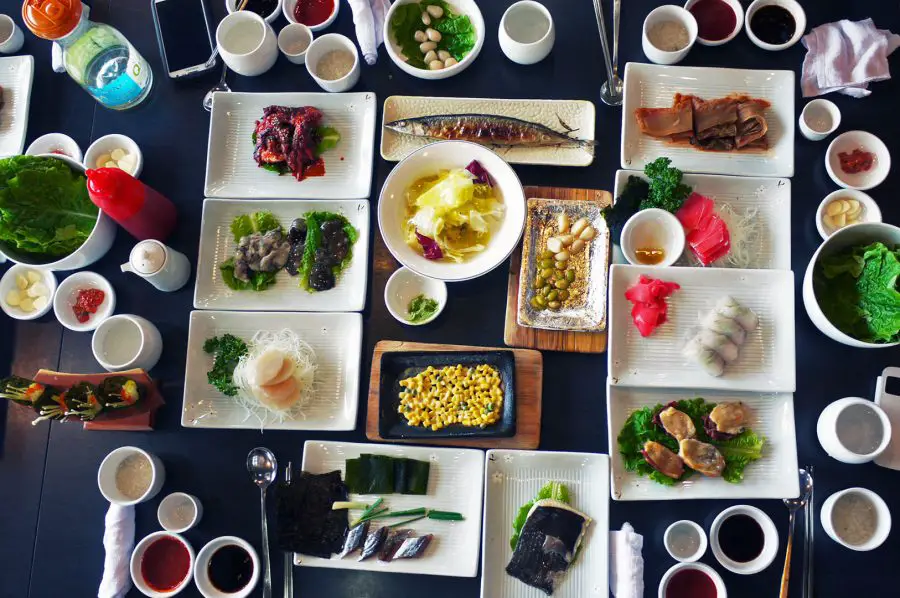
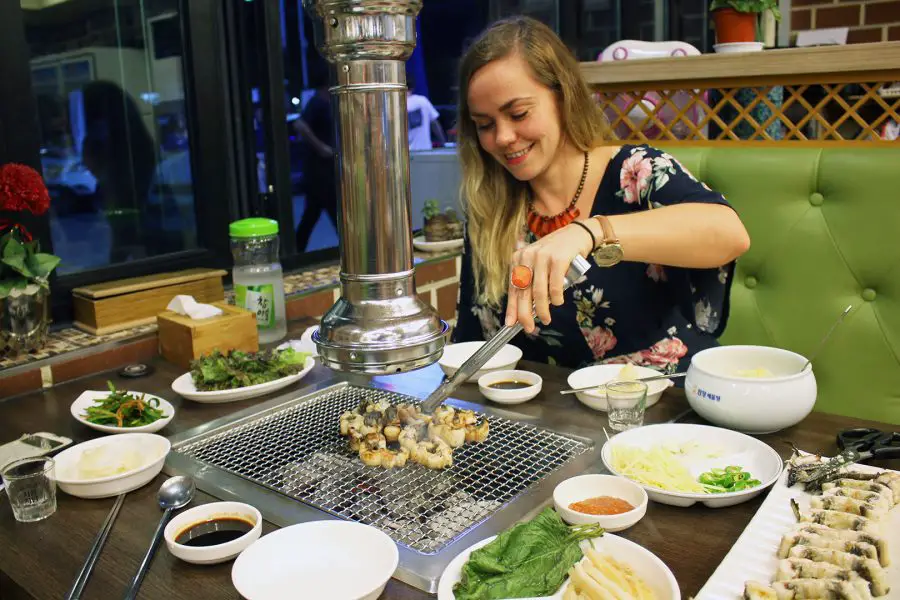
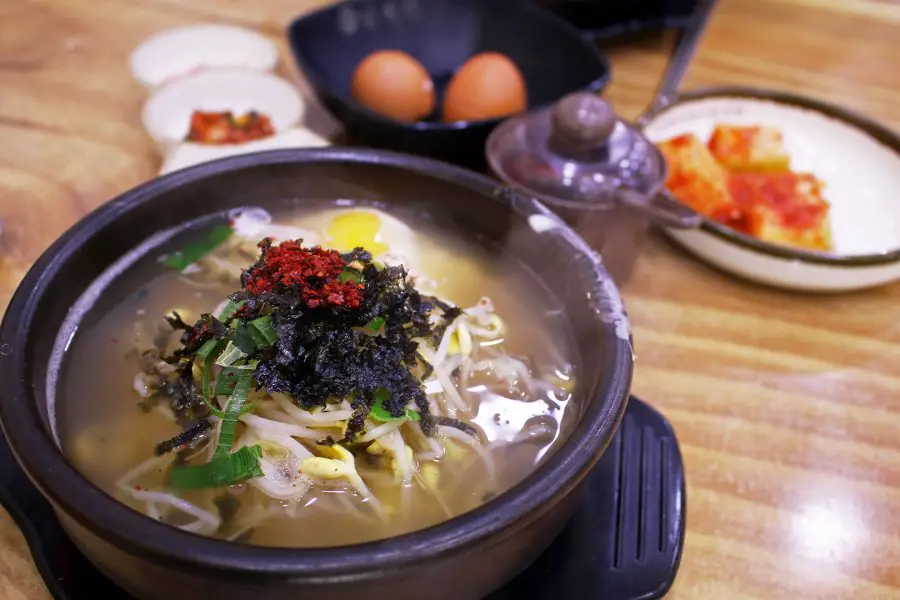
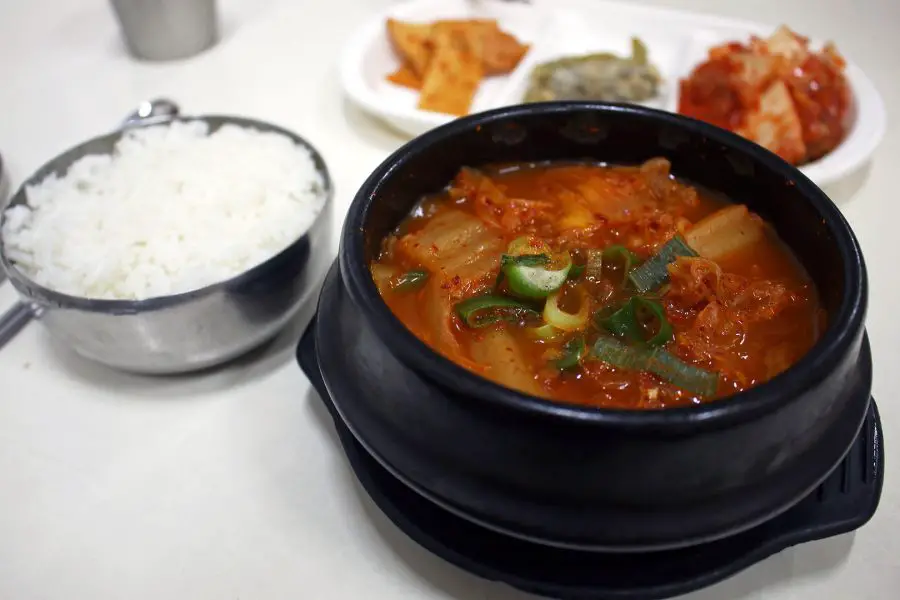
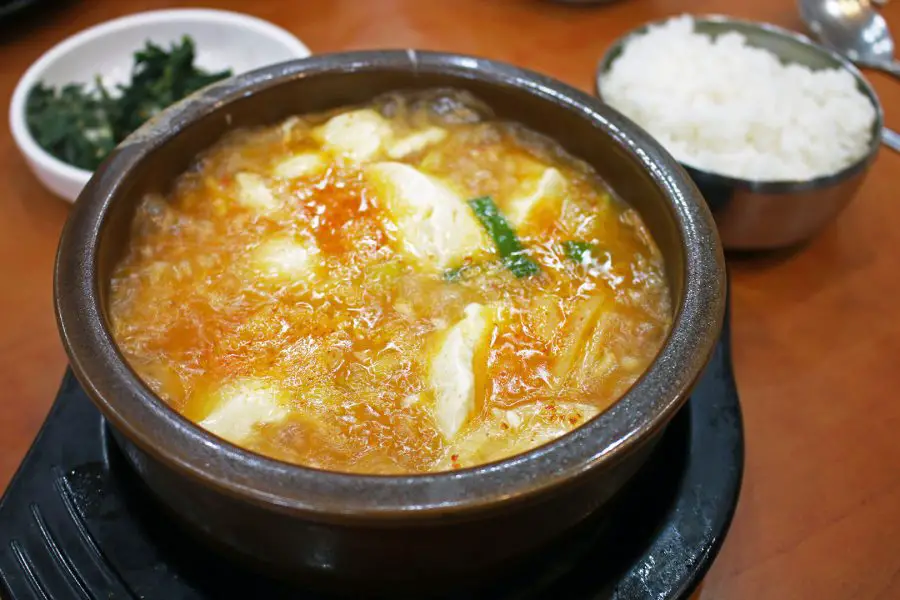
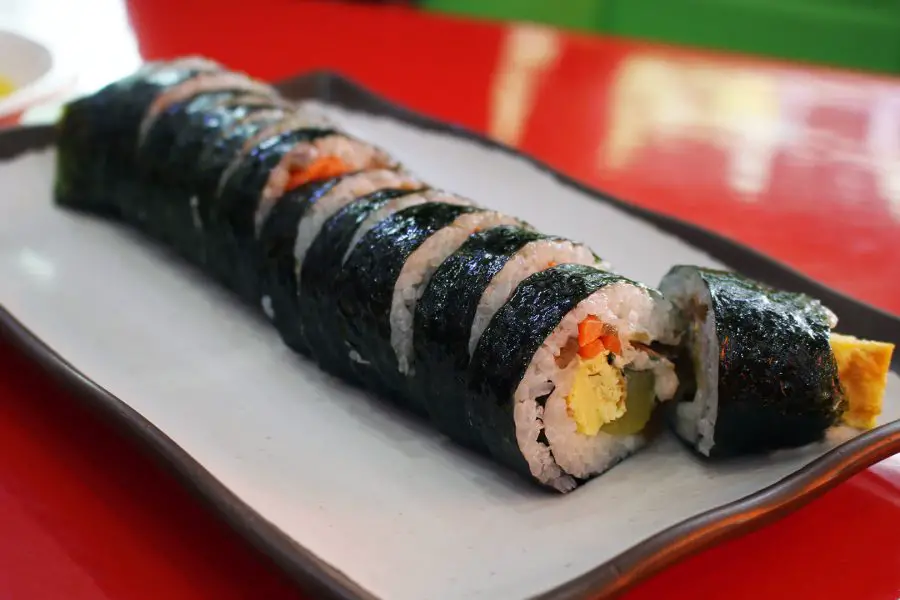
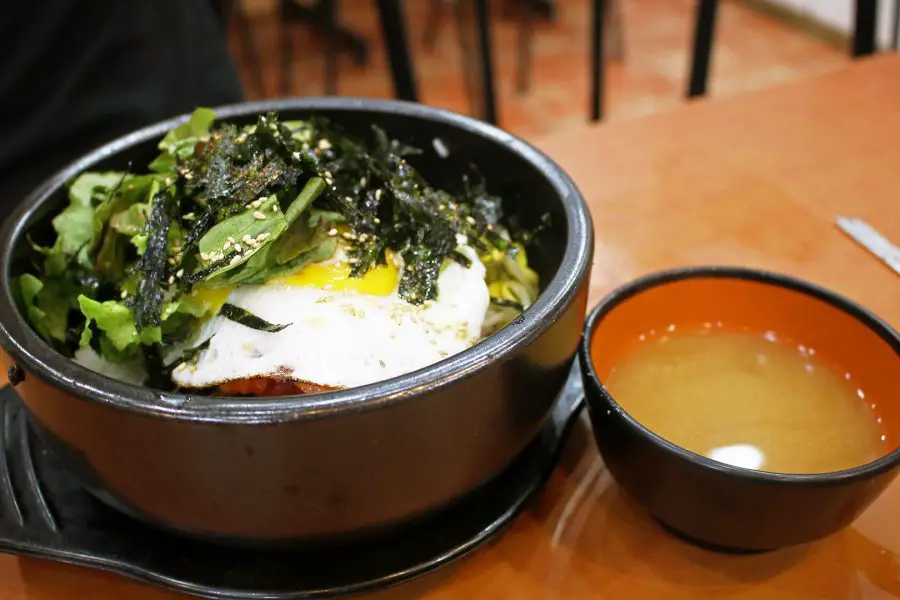
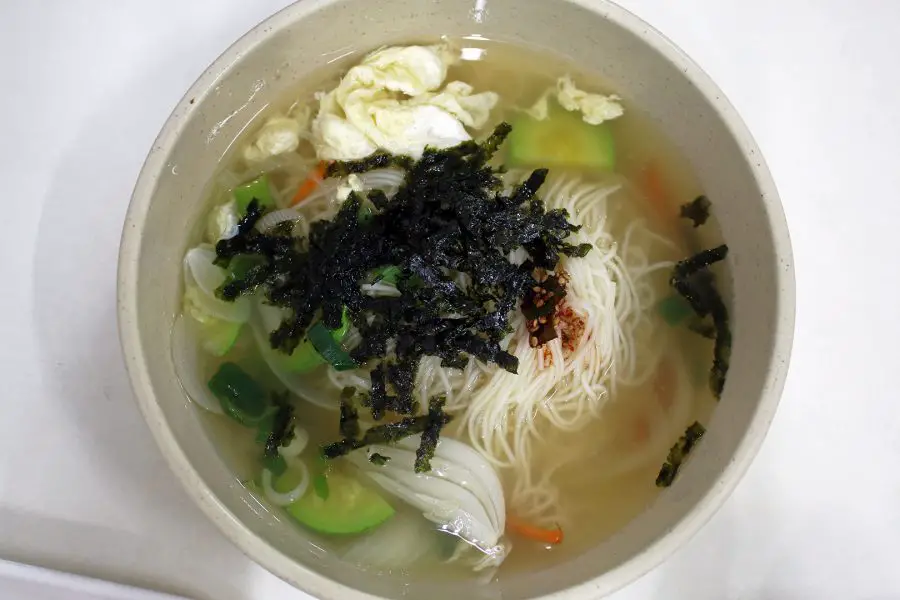
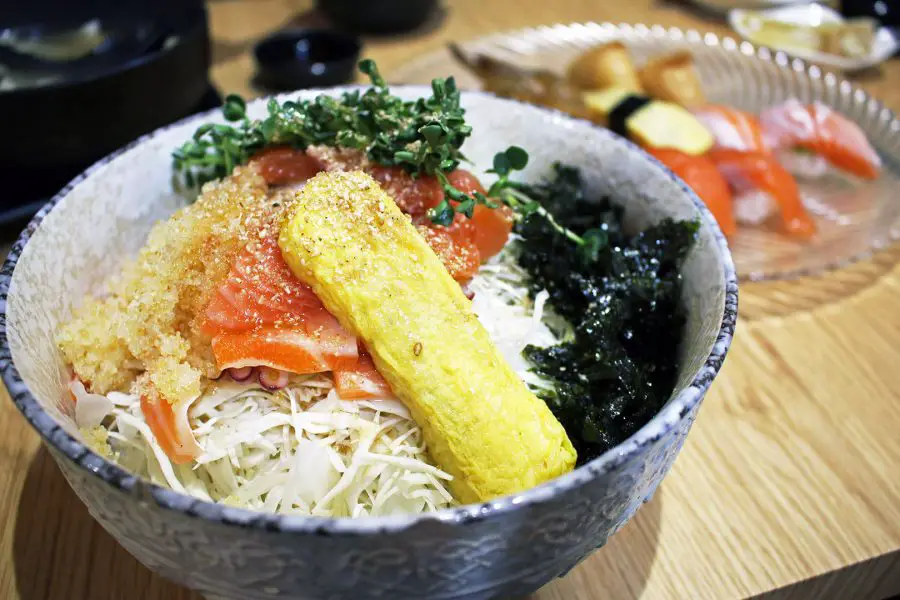
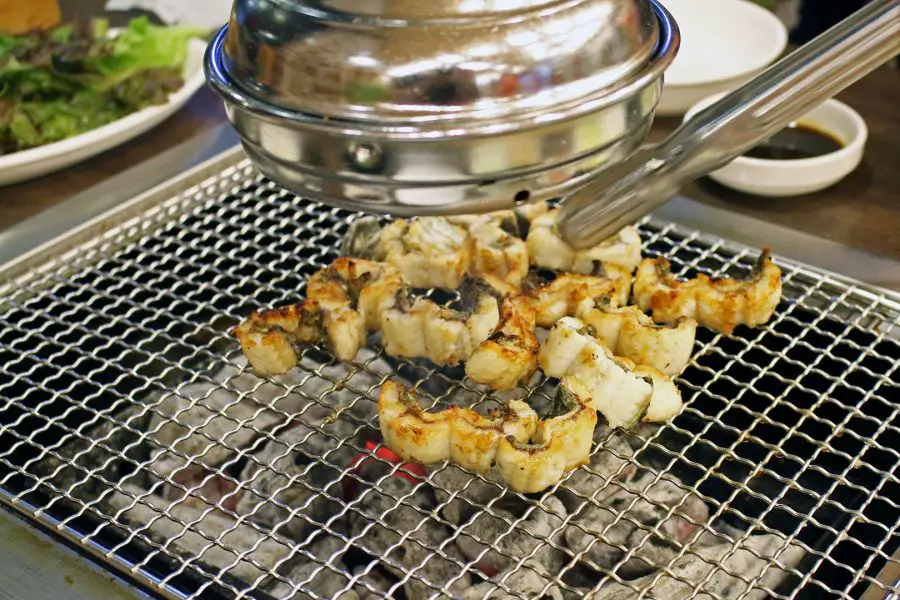
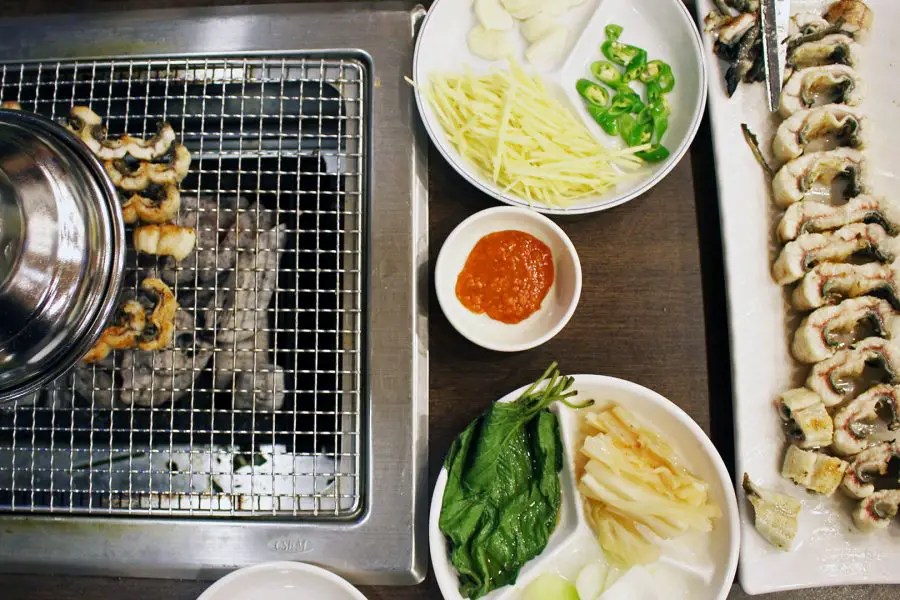
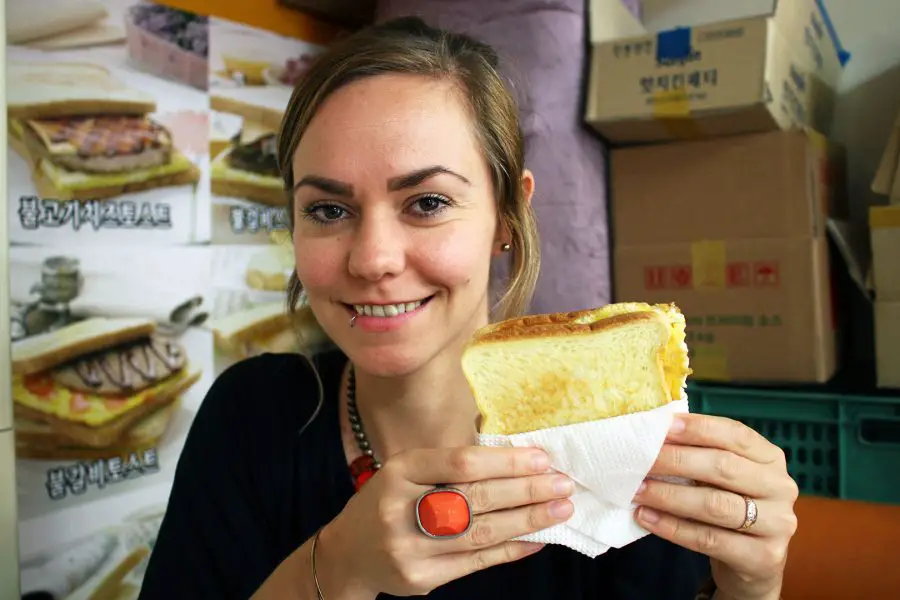

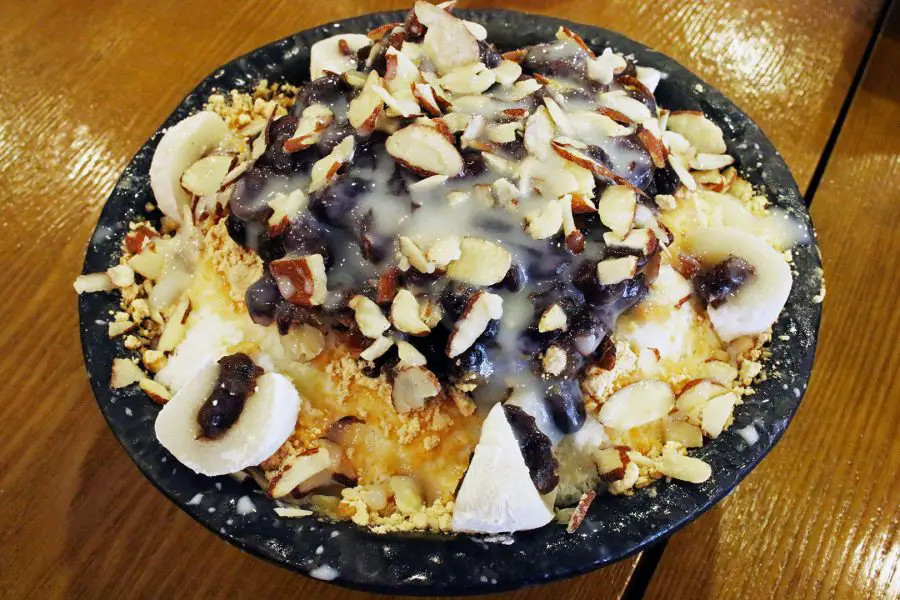

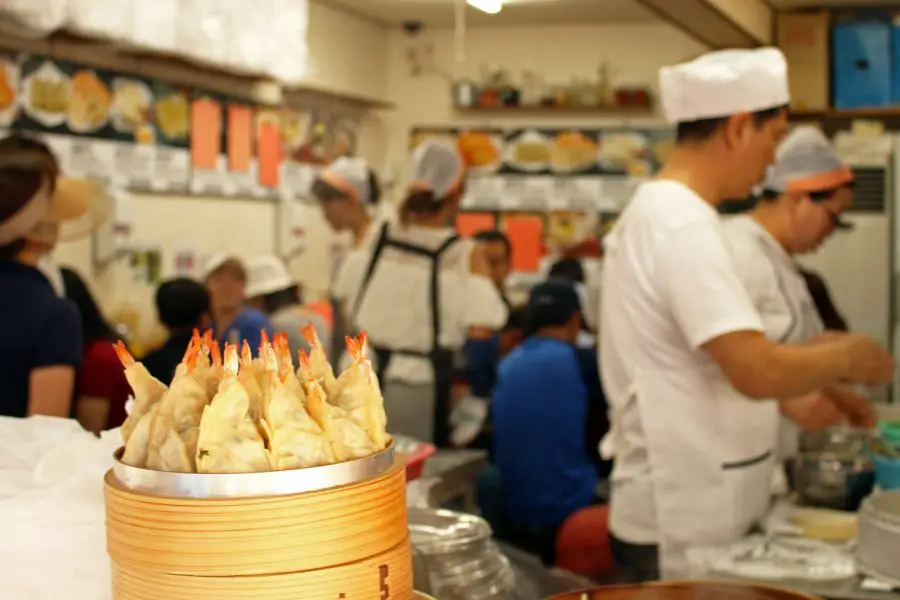
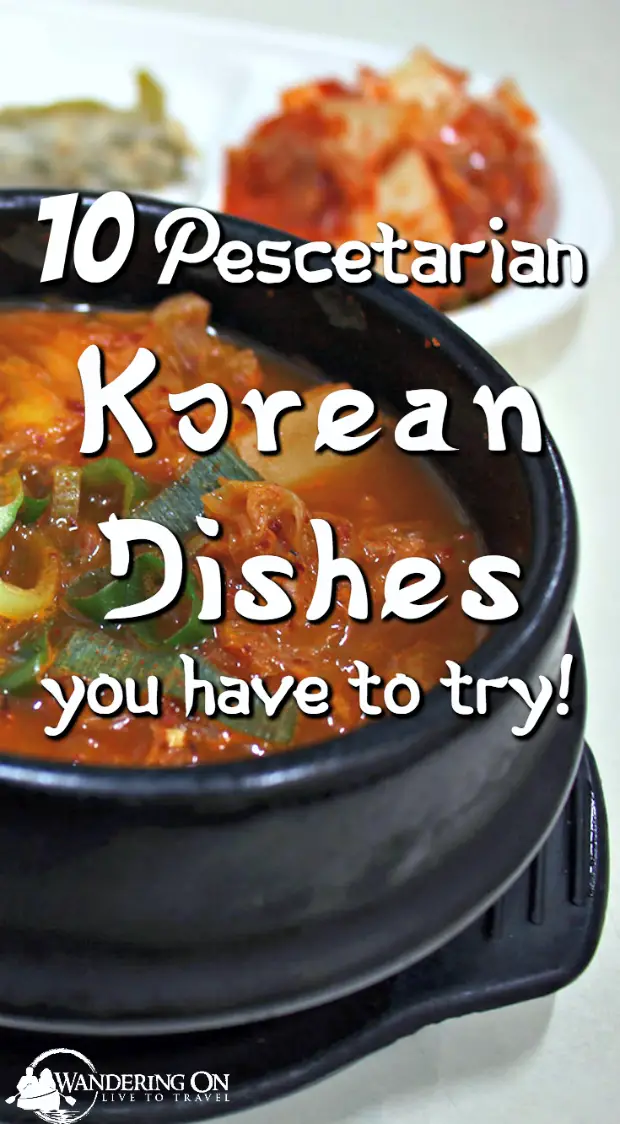



Thank you for explaining that at first, it can take a little while to get used to the tastes and textures of Korean food. My sister loves Korean food, and really wants to take me to a bbq place. I bet we could find one near me to go to when she comes to visit!
No problem Sandra. I’m sure you can find a Korean BBQ restaurant nearby! Enjoy!
Tell me something about dishes consisting of only chicken and /or fish. No pork or beef.
Hi Amit. All of the dishes listed above are suitable for either vegetarians or pescetarians, (ie. those who only eat seafood but no meat) but may need some adjustments as outlined in the post.
Korean fried chicken is very popular, commonly called Chimaek (Korean: 치맥) – a combination of Chicken and Maekju (beer in Korean). Dak-galbi (닭갈비) is another popular Korean dish with chicken – a spicy mix of chicken, cabbage and sometimes dakpoki or even cheese on top – it’s cooked on the table in front of you in the restaurant. Hope that helps!:)
Could I eat Kimchi Topokki and black bean noodles as a Pescetarian. I’ve always wanted to try it but don’t wanna go off being what I am.
Hi Al,
You could of course eat both of these dishes as most dishes in Korea either have a fish-based stock and kimchi is traditionally made with dried shrimp so as a pescetarian you’re okay with these as long as you say “gogi up-soy-o” or “gogi bae-go” which means “without meat” when ordering!
Great post, excellent photos and looks delicious!!!
Thanks Samantha – glad you enjoyed our post! 🙂
Wow its look Delicious food .Thanks for sharing post.
No problem, we love Korean food!
Hi Laura,
Thanks so much – glad you enjoyed the post!
Yeah, it can be annoying in Korea and even other countries at times, so that’s why we still eat seafood (and because we adore sushi! 🙂 ).
Even at home in Ireland, when eating out in more traditional places (which would still be very much a meat and two veg culinary scene) with family, if you don’t at least eat fish you’re going to be stuck with a veggie pasta/noodle dish – not convenient for Brian who is also gluten intolerant!
Yeah, we didn’t mind fish broths and picking some pork out of kimchi jjigae’s too but it must be a nightmare for people living there who aren’t okay with that. I wonder how vegans get by in Korea? In some countries, like Spain and even in Korea vegetarian seems to mean that you’ll still eat seafood so it can be confusing.
And yes, we agree even in Southeast Asia vegetarianism seems to be more understood. The Indian subcontinent is great too – vegetarian bliss! 🙂
Great post! Shout out to dolsot bibimbap for being the M.V.P. of the Korean veggie food game! As a non-fish eating vegetarian, I found it sort of annoying to live and EAT in Korea for 2.5 years. After leaving and traveling, I realize how accommodating and understanding other Asian cultures are of vegetarianism is, and it makes my days run a bit smoother. While I haven’t eaten meat in the past 11+ years, I did occasionally while living there; I ate janchi-guksu (only if my school’s chef made it because she wasn’t TOO heavy on the tuna) and didn’t mind taking the pork out of the kimchi jjigae even if the broth was made primarily of fish. Regardless, this is a wonderful post for those who are confused as to what they can eat.
I tried patbingsu for the first time last week. It was really good. It’s hard for me to find Korean food that I like, so thanks for the info!
Hi Sean,
Patbingsu is soo good and great to cool down in the summer heat!
Glad you enjoyed the post! 🙂
You’re making me hungry!!!
I love eel so I’m gonna try that dish next. And I agree that it’s very hard to be a vegetarian in Korea.
Sorry Hanani!
Yeah, it is hard there- that’s why we still eat seafood – so many countries are difficult to be completely vegetarian that it can be convenient to still eat fish.
Yes, please do try the eel barbeque – it’s a bit pricier than meat barbeque but definitely worth it!
Enjoy! 🙂
Man, you’re making me hungry. I’m really picky when it comes to vegetables so I usually just stick to bbq. Hahaa… I really like Isaac toast and patbingsu though. There’s a place where they put fruit loops cereal in the patbingsu, I was addicted to it for the whole summer until they stop selling it. Anyways, great post with great info.
Haha! Sorry about that John! 😉
Glad you liked the post! Mmm – patbingsu! 😀
Thanks so much for sharing this! And serious kudos to you for managing as a veggie here! I have recently become a “weekday veggie” lol. I only eat vegetarian food (pretty much vegan since dairy costs an arm and a leg here!) through the week and at home. Eating out is a bit troubling. I feel as though so much food could easily be veggie friendly but isn’t. I was out for dalk galbi last night and was saying to my boyfriend that if you swapped the chicken for mushrooms, you could easily have a veggie friendly meal! It’s definitely difficult to find veggie friendly meals at restaurants. This list is definitely helpful though! My personal favourite veggie dish is bibimyeon- the cold noodle dish. Plus, it’s everywhere now that it’s summer which is great!
Thanks for sharing, I think this will defos help a lot of veggies in Korea!
Hi Nicole,
Luckily for us, both times we lived in Korea, for three and half years total, we still ate meat but our consumption of red meat slowly went down as beef is quite expensive to buy and we only ate red meat when we went out for Korean BBQ.
After travelling in Nepal and India, we got quite into veggie food and when we went back to Korea for our second contract we ate more tofu and seafood dishes than the first time round.
Yeah, we agree it can be difficult there – it can even be hard to find things chickpeas and lentils in the supermarkets! So, when we recently re-visited for a month we wanted to highlight how you can make some meals vegetarian or at least pescetarian and luckily for us we still eat seafood, as it’s quite difficult to find pure vegetarian in Korea as a lot of the broths, etc. are fish based and there’s ‘surprise meat’ in a lot of dishes!
We’re so happy that you liked this post and think it will help veggies in Korea out! 🙂
Yummy post! I love Korean food and especially the grilled eel from your list.
Hi Alla,
Glad you liked it! Would love some grilled eel right now! Miss Korean food! 🙂
This post is great! Especially since so much of the food here is based around meat! I’m a huge lover of kimchi jiggae and dolsot bibimbap- great shoutouts! I always thought it would be difficult for my vegetarian friend to visit me in Korea, but now I’m realizing it really isn’t that difficult to find meatless food. I haven’t tried eel bbq, would love to give that a taste before we leave! Thanks for sharing!
Hi Megan,
So glad you enjoyed this post! We love kimchi jiggae and dolsot bibimbap – nyom! Wold love either right now! 😀 Hope your vegetarian friend does get to visit you!
Oh and do try the eel barbeque before you leave – it’s sooo good! A bit more expensive than meat barbeque but so worth it!
Enjoy! 🙂
Your post seriously made me drool! It looks so yummy! I don’t know why people complain that Koreans eat too much meat. Many of the dishes you mentioned on this list are the foods I frequently enjoy! I’ll definitely be sharing your post! 🙂
Hi Gina,
We agree – we always got the feeling that BBQ and meat dishes were things Koreans ate as a treat and not every single day as their breakfasts and lunches always seemed to consist of only a small amount of meat. There is so much more to Korean cuisine than BBQ and fried chicken!
We’re so glad you enjoyed the post and thanks for sharing! 🙂
Awesome post! Your description of the dishes was so thorough. I’m currently teaching English in Daegu, so I’m familiar with most of these dishes. I know you’re not meat-eaters, but I have to say my favorite so far is 닭갈비! I really enjoyed reading your post 😀
P.S. I looked at your site and read your story of becoming digital nomads…it’s truly inspiring to me, because I’m planning to pursue that lifestyle after my teaching contract ends. I would love to keep in touch!
Hi Matthew,
Sorry for the ridiculous delay in our reply! We’re so glad you enjoyed the post! We used to eat meat when we lived in Korea so we have tried 닭갈비 and it is delicious! 🙂
We recently re-visited for a month and wanted to highlight some less meat-heavy dishes that people might not know about unless they’ve live in Korea – because everyone seems to know about Korean BBQ and fried chicken!
We never made it to Daegu as we always went to Busan but we’ve heard from other waygooks that it’s a cool city to live in.
We’re so happy that we’ve inspired you to pursue a digital nomad lifestyle. Definitely do keep in touch, we’d be happy to help you if you have any questions.
화이팅! 😉
Well, I’m a non-fish eating meat eater so I doubt I have any tips that are useful. Great selection of food though.
Sorry Emre! 🙂 Plenty of BBQ meat in Korea for you to enjoy at least! 😉
Hi Noelle,
This was interesting and helpful. I’ll be going to Korea for the first time in a couple of weeks with my French husband – who is primarily a pescatarian (but will eat chicken, lamb, rabbit and duck on occasion, just not pork or beef), my youngest is 20 and raised as a pescatarian but now trying to be vegan (with pasture-raised eggs only and limited cheese), and my 23 yr old, who is married to a Korean, and can find a few things she can eat there (she’s been before) but it’s challenging as she has a food disorder causing aversion to most things (I saw that grilled cheese looking thing…that would work for her! I’ll have to ask about that one…as long as it’s PLAIN grilled cheese)
Our issue is going to be: none of us eat SPICY food, or oily food. 😮 will we survive?
I am trying to learn the Korean phrase “I don’t eat meat, I only eat fish”
I have read, as you also mention, that even when you say you don’t eat meat, they don’t really get it (I have had this issue in France for nearly 30 years but I speak the language so it’s easier).
I have not eaten ANY meat in over 30 years and my 20 yr old won’t go near it. (we’ve told her she’ll have to eat fish while we’re there).
Do you have other suggestions or ways we can make ourselves understood? Sometimes we’ll have my son in law w us to help, sometimes we’ll be on our own in Seoul, Daegu and Busan. (mostly Seoul)
Thanks for your article and help!
Hi Annemarie,
That’s exciting – we hope all goes well with the move and you have a great time! With regards to your dietary requirements – I’m not going to lie… it will be challenging but certainly not impossible! 🙂 Also, having a Korean to help you out will be a HUGE help! first of all, in terms of being vega, it’s important to be aware that a lot of Korean dishes have shrimp paste in them, so even though they might seem like there is no meat it can often be in the broth or hidden elsewhere in the dish – even Kimchi is made with dried shrimp most of the time.
Being vegetarian is not very usual in Korea, however, you can normally find some options like those listed in the post above. There are also quite a few international restaurants, particularly in the bigger cities. In Seoul there are even a few (not many) restaurants/cafes that will cater to vegans.
To be better understood, the best thing to do is ask your son in law to write down your dietary requirements in Korean or keep a copy of what he writes on your phone. If you show this note to the restaurant staff they will understand and will try and help. Koreans are very helpful and accommodating and will do their very best to ensure your needs are met.
We hope the above is helpful. Best of luck with the move – we hope everything goes well for you all! 🙂